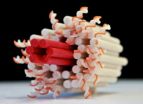(Press-News.org) Scientists at the Mainz University Medical Center have discovered another molecule that plays an important role in regulating myelin formation in the central nervous system. Myelin promotes the conduction of nerve cell impulses by forming a sheath around their projections, the so-called axons, at specific locations – acting like the plastic insulation around a power cord. The research team, led by Dr. Robin White of the Institute of Physiology and Pathophysiology at the University Medical Center of Johannes Gutenberg University Mainz, recently published their findings in the prestigious journal EMBO reports.
Complex organisms have evolved a technique known as saltatory conduction of impulses to enable nerve cells to transmit information over large distances more efficiently. This is possible because the specialized nerve cell axonal projections involved in conducting impulses are coated at specific intervals with myelin, which acts as an insulating layer. In the central nervous system, myelin develops when oligodendrocytes, which are a type of brain cell, repeatedly wrap their cellular processes around the axons of nerve cells forming a compact stack of cell membranes, a so-called myelin sheath. A myelin sheath not only has a high lipid content but also contains two main proteins, the synthesis of which needs to be carefully regulated.
The current study analyzed the synthesis of myelin basic protein (MBP), a substance which is essential for the formation and stabilization of myelin membranes. In common with all proteins, MBP is generated in a two-stage process originating from basic genetic material in the form of DNA. First, DNA is converted to mRNA, which, in turn, serves as a template for the actual synthesis of MBP. During myelin formation, the synthesis of MBP in oligodendrocytes is suppressed until distinct signals from nerve cells initiate myelination at specific "production sites". To date, the mechanisms involved in the suppression of MBP synthesis over relatively long periods of time have not been understood. This is where the current work of the Mainz scientists comes in, as they were able to identify a molecule that is responsible for the suppression of MBP synthesis.
"This molecule, called sncRNA715, binds to MBP mRNA, thus preventing MBP synthesis," explains Dr. Robin White. "Our research findings show that levels of sncRNA715 and MBP inversely correlate during myelin formation and that it is possible to influence the extent of MBP production in oligodendrocytes by artificially modifying levels of sncRNA715. This indicates that the recently discovered molecule is a significant factor in the regulation of MBP synthesis."
Understanding the molecular basis for myelin formation is essential with regard to various neurological illnesses that involve a loss of the protective myelin layer. For example, it is still unclear why oligodendrocytes lose their ability to repair the damage to myelin in the progress of multiple sclerosis (MS). "Interestingly, in collaboration with our Dutch colleagues, we have been able to identify a correlation between levels of sncRNA715 and MBP in the brain tissue of MS patients," Robin White continues. "In contrast with unaffected areas of the brain in which the myelin structure appears normal, there are higher levels of sncRNA715 in affected areas in which myelin formation is impaired. Our findings may help to provide a molecular explanation for myelination failures in illnesses such as multiple sclerosis."
### END
Scientists at Mainz University identify inhibitor of myelin formation in the central nervous system
Possible implication for various neurological illnesses / Publication in EMBO reports
2012-11-20
ELSE PRESS RELEASES FROM THIS DATE:
Researchers build synthetic membrane channels out of DNA
2012-11-20
As reported in the journal Science, physicists at the Technische Universitaet Muenchen (TUM) and the University of Michigan have shown that synthetic membrane channels can be constructed through "DNA nanotechnology." This technique employs DNA molecules as programmable building materials for custom-designed, self-assembling, nanometer-scale structures. The researchers present evidence that their nature-inspired nanostructures may also behave like biological ion channels. Their results could mark a step toward applications of synthetic membrane channels as molecular sensors, ...
Is Facebook a factor in psychotic symptoms?
2012-11-20
As Internet access becomes increasingly widespread, so do related psychopathologies such as Internet addiction and delusions related to the technology and to virtual relationships. Computer communications such as Facebook and chat groups are an important part of this story, says Dr. Uri Nitzan of Tel Aviv University's Sackler Faculty of Medicine and the Shalvata Mental Health Care Center in a new paper published in the Israel Journal of Psychiatry and Related Sciences.
In his study, the researcher presented three in-depth case studies linking psychotic episodes to Internet ...
How healthy are young people's lifestyles?
2012-11-20
This is the question asked by two of the articles in this week's issue of Deutsches Ärzteblatt International. Dieter Leyk from German Sport University Cologne (Deutsche Sporthochschule Köln) and coauthors investigated the effects of unhealthy lifestyles on young people's fitness, Sabine Stamm-Balderjahn from Berlin's Charité, and her coauthors report a study investigating the effects of a hospital-based intervention program to prevent smoking in school students (Dtsch Arztebl Int 2012; 109(44): 737-45 und Dtsch Arztebl Int 2012; 109(44): 746-52).
Leyk et al. collected ...
Researchers implicate well-known protein in fibrosis
2012-11-20
Chicago --- An international multi-disciplinary research team led by Northwestern Medicine scientists has uncovered a new role for the protein toll-like receptor 4 (TLR4) in the development of tissue fibrosis, or scarring.
This finding, recently reported in the American Journal of Pathology, has implications for the treatment of scleroderma, a condition for which there currently is no effective treatment.
TLR4 was previously implicated in inflammation, but its role in tissue fibrosis was unknown. Fibrosis is a hallmark of scleroderma and contributes to a range of common ...
Teens in arts report depressive symptoms, study says
2012-11-20
WASHINGTON – Teens who participate in after-school arts activities such as music, drama and painting are more likely to report feeling depressed or sad than students who are not involved in these programs, according to new research published by the American Psychological Association.
This is the first study to find that young people's casual involvement in the arts could be linked to depressive symptoms, according to the researchers. The article was published online in APA's journal Psychology of Aesthetics, Creativity, and the Arts.
"This is not to say that depression ...
Planck spots hot gas bridging galaxy cluster pair
2012-11-20
ESA's Planck space telescope has made the first conclusive detection of a bridge of hot gas connecting a pair of galaxy clusters across 10 million light-years of intergalactic space.
Planck's primary task is to capture the most ancient light of the cosmos, the Cosmic Microwave Background, or CMB. As this faint light traverses the Universe, it encounters different types of structure including galaxies and galaxy clusters – assemblies of hundreds to thousands of galaxies bound together by gravity.
If the CMB light interacts with the hot gas permeating these huge cosmic ...
Music to the ears for a good night's sleep?
2012-11-20
WINSTON-SALEM, N.C. – Nov. 20, 2012 – If you are among the 50 percent of Americans who suffer from insomnia, then you have probably tried everything – from warm milk to melatonin pills or prescription medications to induce sleep – with varying degrees of success and side effects. But what if sleep could be achieved not by a substance, but through 'balancing' brain activity?
Researchers at Wake Forest Baptist Medical Center have conducted a pilot clinical study to determine whether a non-invasive approach, that uses musical tones to balance brain activity, can 'reset' ...
Maple syrup, moose, and the local impacts of climate change
2012-11-20
Millbrook, N.Y. -- In the northern hardwood forest, climate change is poised to reduce the viability of the maple syrup industry, spread wildlife diseases and tree pests, and change timber resources. And, according to a new BioScience paper just released by twenty-one scientists, without long-term studies at the local scale—we will be ill-prepared to predict and manage these effects.
Following an exhaustive review of more than fifty years of long term data on environmental conditions at the Hubbard Brook Experimental Forest, located in the White Mountains of New Hampshire, ...
Timely change for tweeters' tune
2012-11-20
Do birds change their tune in response to urban noise? It depends on the bird species, according to Dr. Alejandro Ariel Ríos-Chelén from the Universidad Nacional Autónoma de México and colleagues. Their work shows that while some birds do adapt their songs in noisy conditions by means of frequency changes, others like the vermilion flycatchers adapt their song by means of changes in song lengths. The work is published online in Springer's journal, Behavioral Ecology and Sociobiology.
Birds use their songs during social interactions to attract females and repel intruders. ...
Huddersfield professor's ground-breaking research shows just how well the 2012 Games were run
2012-11-20
UNIQUE research conducted by a University of Huddersfield professor confirms just how successfully the 2012 Olympics and Paralympics were designed, organised and delivered. His findings will reveal to planners of the 2016 Games in Brazil just what they must do to meet or exceed the standards set by London.
Professor David Bamford, an expert in the theory of operations management and how it can be applied to the sports arena, was granted full access to the Paralympics village in London and with his team of researchers he quizzed hundreds of athletes, seeking their views ...
LAST 30 PRESS RELEASES:
Tracing the quick synthesis of an industrially important catalyst
New software sheds light on cancer’s hidden genetic networks
UT Health San Antonio awarded $3 million in CPRIT grants to bolster cancer research and prevention efforts in South Texas
Third symposium spotlights global challenge of new contaminants in China’s fight against pollution
From straw to soil harmony: International team reveals how biochar supercharges carbon-smart farming
Myeloma: How AI is redrawing the map of cancer care
Manhattan E. Charurat, Ph.D., MHS invested as the Homer and Martha Gudelsky Distinguished Professor in Medicine at the University of Maryland School of Medicine
Insilico Medicine’s Pharma.AI Q4 Winter Launch Recap: Revolutionizing drug discovery with cutting-edge AI innovations, accelerating the path to pharmaceutical superintelligence
Nanoplastics have diet-dependent impacts on digestive system health
Brain neuron death occurs throughout life and increases with age, a natural human protein drug may halt neuron death in Alzheimer’s disease
SPIE and CLP announce the recipients of the 2025 Advanced Photonics Young Innovator Award
Lessons from the Caldor Fire’s Christmas Valley ‘Miracle’
Ant societies rose by trading individual protection for collective power
Research reveals how ancient viral DNA shapes early embryonic development
A molecular gatekeeper that controls protein synthesis
New ‘cloaking device’ concept to shield sensitive tech from magnetic fields
Researchers show impact of mountain building and climate change on alpine biodiversity
Study models the transition from Neanderthals to modern humans in Europe
University of Phoenix College of Doctoral Studies releases white paper on AI-driven skilling to reduce burnout and restore worker autonomy
AIs fail at the game of visual “telephone”
The levers for a sustainable food system
Potential changes in US homelessness by ending federal support for housing first programs
Vulnerability of large language models to prompt injection when providing medical advice
Researchers develop new system for high-energy-density, long-life, multi-electron transfer bromine-based flow batteries
Ending federal support for housing first programs could increase U.S. homelessness by 5% in one year, new JAMA study finds
New research uncovers molecular ‘safety switch’ shielding cancers from immune attack
Bacteria resisting viral infection can still sink carbon to ocean floor
Younger biological age may increase depression risk in older women during COVID-19
Bharat Innovates 2026 National Basecamp Showcases India’s Most Promising Deep-Tech Ventures
Here’s what determines whether your income level rises or falls
[Press-News.org] Scientists at Mainz University identify inhibitor of myelin formation in the central nervous systemPossible implication for various neurological illnesses / Publication in EMBO reports



